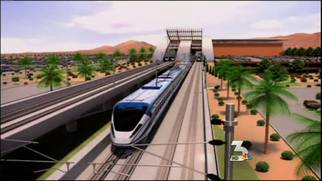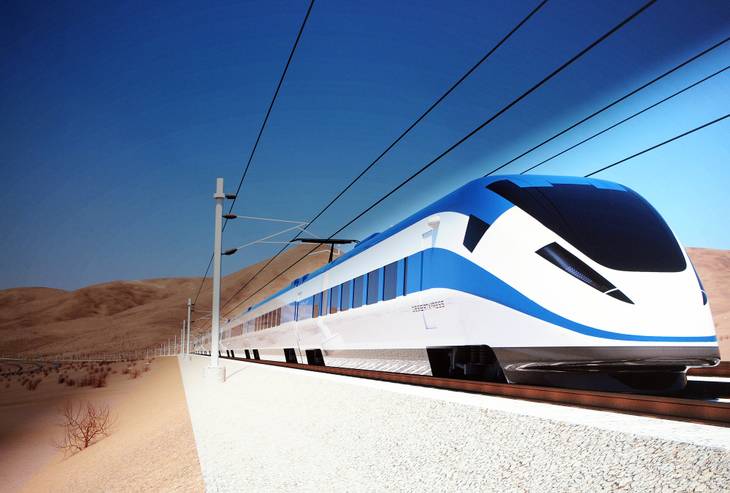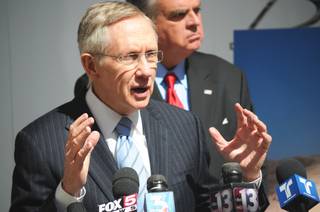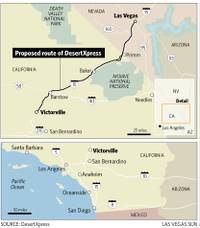KSNV: DesertXpress EIS

Viewing video requires the latest version of Adobe's Flash Player
KSNV coverage of announced completion of environmental impact statement for DesertXpress high-speed rail project between Las Vegas and California, March 25, 2011.
Sun archives
- Is America ready to manage high-speed rail? (4-27-2011)
- DesertXpress high-speed rail project rolls forward (3-25-2011)
- DesertXpress rail project going after tax dollars, after all (2-21-2011)
- DesertXpress top executive retires from high-speed rail project (12-17-2010)
- With new leaders, a revival of maglev high-speed rail? (11-25-2010)
- Harry Reid hopeful DesertXpress gets support from next governor (10-13-2010)
- Transportation secretary envisions nation connected by high-speed rail (10-13-2010)
While DesertXpress Enterprises awaits a record of decision from the Federal Railroad Administration that would enable it to begin building its privately funded high-speed rail line between Las Vegas and Victorville, Calif., residents of the city’s southwestern neighborhoods are growing wary of how the train line is going to affect them and their property.
A representative of the train company spent about an hour at Wednesday’s Enterprise Town Advisory Board meeting explaining the status of the $6 billion project, which has been in the planning stages for more than six years.
Greg Gilbert, lead counsel for DesertXpress, told the nearly 50 neighborhood residents that a route for the train hasn’t been finalized, but the company is expecting the record of decision soon. Once that has been published, DesertXpress can begin engineering where the tracks coming into Las Vegas will be placed.
The final environmental impact statement developed by five government entities has indicated the route would be roughly along the Interstate 15 corridor from Primm. Some alternative routes are listed in the impact statement, and the agencies working on the project have chosen two prospective Las Vegas station sites. Both are on the west side of I-15, one just north of Russell Road and the other near the Rio hotel-casino at Flamingo Road.
Gilbert said that until the record of decision is published, the company can’t address many individual concerns.
The non-profit Dean Martin Rural Neighborhood Preservation Association already has written to the Federal Railroad Administration opposing the FRA’s preferred route, because of the potential impact on homes and businesses along Dean Martin Avenue from Cactus to Wigwam avenues.
“After reviewing the final environmental impact statement, we have found several concerns and impact issues that have not been addressed,” the organization’s letter says. “We believe the ‘preferred alternative’ route for the DesertXpress train would negatively affect our area.”
The letter cites train noise, area land use, safety, effects on air traffic at McCarran International Airport and the visual impact of the train as negative impacts.
Gilbert told residents that no grade crossings are planned for the train, leading some to worry that the track would be elevated and a greater visual nuisance. Some residents said they would prefer the train enter the Las Vegas area along the Union Pacific railroad right-of-way farther west of I-15.
Gilbert said officials at McCarran and with airlines that fly into the airport already have commented on the proposed height of an elevated track. He said the railroad would comply with construction and design standards established by the Nevada Department of Transportation and its California counterpart, Caltrans.
While most of the neighbors had questions about the train route, some also questioned how the train would be financed and whether the business plan would succeed.
DesertXpress has applied for a $4.9 billion federal loan through the Railroad Rehabilitation & Improvement Financing program. Gilbert said approval of that loan is key to the success of the project. It is expected to take three years to build the train line and a year to commission it for revenue service, he said. Construction would take place in several locations along the route simultaneously, he said.
Concurring with the crowd that project is designed more to bring tourists from Southern California to Nevada than to serve Southern Nevadans going to California, Gilbert said the company believes “anything that brings tourists to Las Vegas is productive for the city.”
The 185-mile, dual-track project would include electric-powered steel-wheel-on-rails technology. The company has proposed linking Victorville with Palmdale, Calif., 50 miles west of where the California High-Speed Rail line is proposed, but no companies or organizations have announced plans to build it.


